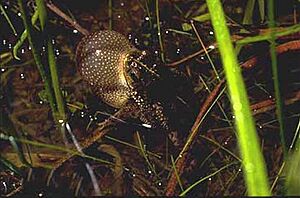Rhinella dorbignyi facts for kids
Quick facts for kids Rhinella dorbignyi |
|
|---|---|
 |
|
| Conservation status | |
| Scientific classification | |
| Synonyms | |
|
Meet Rhinella dorbignyi, a type of toad found in South America. It belongs to the true toad family, called Bufonidae. This toad is also known as d'Orbigny's toad. It was named after a French naturalist, Alcide d'Orbigny.
Scientists sometimes study how different toad species are related. Rhinella dorbignyi can sometimes breed with another toad called Rhinella fernandezae.
Contents
About D'Orbigny's Toad
What Does It Look Like?
Male d'Orbigny's toads are usually about 3.6 to 6.4 centimeters (1.4 to 2.5 inches) long. Females are a bit bigger, measuring about 4.2 to 6.9 centimeters (1.7 to 2.7 inches). One very large toad was even found to be 7.7 centimeters (3 inches) long!
Their heads are round and sit high on their bodies. They have a special ridge above their eyes called a supraorbital crest. This crest is thick and goes all the way across. The skin on their back, called the dorsum, has bumps of different sizes. These bumps can be pointy or rounded.
Where Does It Live?
D'Orbigny's toad lives in several countries in South America. You can find it in:
Its Home and Habits
D'Orbigny's toad likes to live in open areas. This includes places like pastures and the wide-open grasslands known as the Pampas. It can even live in areas where there is a lot of farming. This toad is quite common and is not currently in danger of disappearing.
These toads are "sit-and-wait" predators. This means they wait quietly for their food to come by. They often hide in small holes or under stones. They keep their heads at the entrance, ready to quickly retreat if something disturbs them.
Reproduction and Life Cycle
D'Orbigny's toads usually breed during spring and summer. This happens from October to March. They wait for heavy rains, which create temporary or permanent pools of water. These water bodies are perfect places for them to lay their eggs and for their young to grow.


